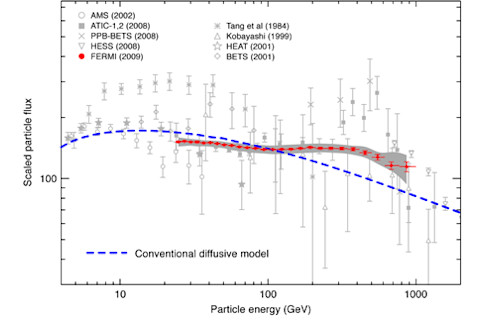For the last few months there's been some excitement among particle-astrophysicists about intriguing results from the PAMELA satellite experiment and the ATIC balloon experiment. (We also blogged about it here and here.) PAMELA claimed to see an excess in the number of high-energy cosmic positrons (anti-electrons) over what you would expect from conventional astrophysical sources, while ATIC (which can't distinguish between positrons and electrons) saw an overall rise in the number of positrons and electrons combined, more or less consistent with what PAMELA saw. One dramatic but plausible explanation for this result is that the positrons are produced when dark matter particles and antiparticles annihilated with each other, which would certainly be exciting. But it wasn't quite a home run, because there was no evidence for the corresponding excess of anti-protons you would probably also expect. (Although that is not a deal-breaker; with a little ingenuity, particle physicists are able to come up with models that produce positrons but not anti-protons.) There was also some controversy when theorists wrote papers trying to fit the data before the data were even published, by snapping pictures of plots shown at conferences with their cell-phone cameras. More than enough drama for a TV movie, I would say. A tinfoil-hat conspiracy theorist might imagine that all the excitement was intentionally manufactured, just so people would pay more attention to the first measurement from the new Fermi (formerly GLAST) gamma-ray telescope. And now those results are in! (Other Fermi results have already appeared, but not about this particular question.) Sadly, the results are "in" in the sense of being published in Physical Review Letters, which helpfully charges $25 if you're not a subscriber. (Presumably it will be on arxiv soon, probably tonight.) The best summary of the results, although somewhat technical, is by Bruce Winstein and Kathryn Zurek at Physics, the American Physical Society's in-house journal that highlights interesting results. And here are those results.

Fermi is more like ATIC than like PAMELA, in that it also cannot distinguish between electrons and positrons, so this graph shows both. The blue line is a simple model that you might expect in the absence of any dark-matter annihilations, and the red points are the Fermi results. If you look very closely, you can see the grey squares representing the ATIC data, which peak way up there between 100 GeV and 1000 GeV of energy. So: hmm. Sadly it's not a completely definitive result, either way. (This is reflected in the coverage in the popular press, where, unlike the physicists, they need to come to a conclusion: Ron Cowen at Science News says "Another Clue in the Case for Dark Matter," while Adrian Cho at ScienceNow says "Lights Out for Dark Matter Claim?" Both do a good job in the body of their articles.) The Fermi data are clearly lower than the ATIC data were -- but they're not quite as low as the simple model would predict. The energy resolution of Fermi also isn't quite as good -- it's harder for them to pinpoint the energy of each particle -- so it's conceivable that there is a sharp peak that simply gets smeared out by their instrument. But I completely agree with Winstein and Zurek's take:
These results, as precise as they are, do not definitively confirm or rule out a DM source. Although the large ATIC excess, which had been consistent with PAMELA, is ruled out, because of uncertainties from charge-dependent modulation in the flux from the solar wind, the Fermi and PAMELA data do remain consistent as having the same source. Since several natural astrophysical explanations can generate the Fermi and PAMELA spectra, the likely course is that one will be found there. It may simply be, as the Fermi paper points out, that the primary electron spectrum in the cosmic-ray source, predicted to fall as ~E^-3.3 (where E is the particle energy), does not fall as steeply as thought in the energy range observed by Fermi.
In other words, it's not too hard to imagine an astrophysical explanation that doesn't require new physics beyond the Standard Model (which would still be interesting). But more data would be nice. We'll keep looking.













